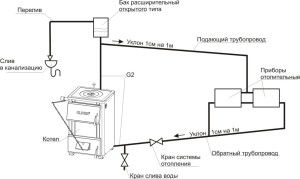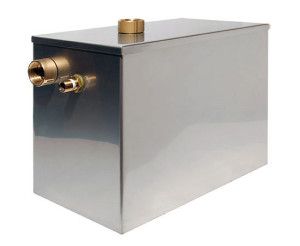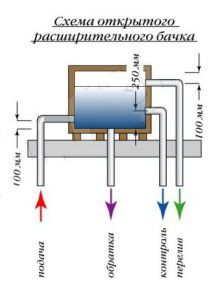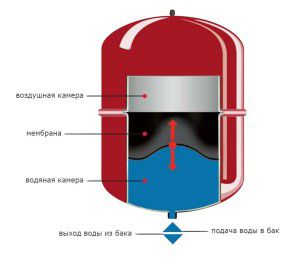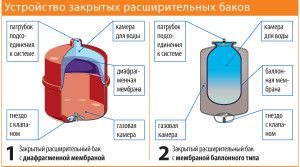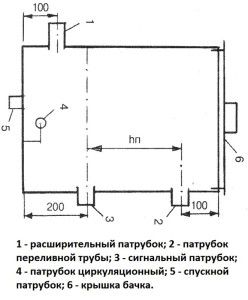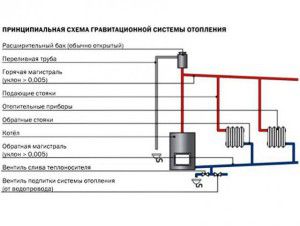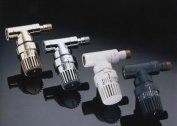How can you effectively stabilize the pressure in the heating system? The solution to this problem is to apply comprehensive measures, including the installation of special components. One of them is an expansion tank for the heating system: closed, open, the pressure in which must be stable under all operating conditions.
Designation of expansion heating tanks
Before considering expansion tanks for the heating system, you need to find out their purpose. It is associated with the property of water or a similar coolant to expand under the influence of temperature. As a result, the pressure in the system increases. Its excess must be compensated.
Using an air vent or similar shutoff valves is effective, but has certain negative aspects. The main one is the exit of water from the system, as a result of which there is a high probability of the formation of air jams. But how does the expansion tank in the heating system work in case of overpressure? Consider the general principle of work on the example of the simplest open model:
- In the normal state, the expansion tank of the closed type is filled by 2/3;
- With increasing volume of the coolant, the level of filling the tank increases, thereby stabilizing the system;
- As soon as the water temperature drops to the optimum level, its volume in the system will decrease to normal;
- At the same time, the coolant level in the tank stabilizes.
Closed models work on the same principle. The difference lies in the design - it is divided into 2 cameras. The first is connected to the heating main and filled with water, and the second creates a pressure equal to normal for this system. Moreover, both chambers are separated by an elastic membrane. As soon as the coolant volume in the pipes exceeds the critical one, the pressure in the heating expansion tank compensates for this process by displacing the membrane. In this way, the actual heating volume is temporarily increased.
For a forced circulation system, it is forbidden to install an open expansion tank. He will not be able to provide the required tightness.
Open expansion tank
The simplest variety are open models. In most cases, they are an unpressurized tank installed at the highest point of the system. This is an important point, since the location of the expansion tank in the heating system directly affects the functional and operational qualities.
The main principle of operation of the expansion tank in the gravity-type heating system is to compensate for the thermal expansion of the coolant. This element can be made independently, or purchased a factory model. Important operational parameters for an open tank are:
- Resistance of the material of manufacture to constant exposure to water and sudden changes in temperature. Stainless steel products have proven themselves best;
- Correctly calculated volume, directly dependent on the amount of water in the system;
- Inability to change location. This is due to the design.
Before installing an expansion tank in an open heating system, you need to familiarize yourself with its advantages.The main one is affordable cost and easy installation. In addition to the traditional scheme, you can make a small upgrade. For this, in addition to the connection pipes to the trunk, additional ones are installed - controlling the minimum liquid level and connected to the make-up pipe to replenish the system.
One of the disadvantages of this design is the constant evaporation of the coolant from the system. At first glance, this figure is insignificant, but if the expansion tank was installed in an unheated attic, the difference in temperature between the air and the coolant will adversely affect the efficiency of the system.
The way out of this situation is to insulate the walls of the tank and install the top cover with a snug fit. In this case, the rate of water evaporation will decrease significantly, and external factors will not affect the temperature mode of operation.
In order to make an expansion tank for heating with your own hands, you can choose the appropriate capacity and install the connecting pipes in it.
It is not recommended to mount plastic containers, as in most cases they are not designed for high temperature effects. The best option is a sealed galvanized metal structure.
Closed expansion tank
It is much more difficult to choose a closed expansion tank. This is due to increased design requirements, as it is designed for operation in systems with high pressure levels.
The role of the expansion tank in the heating system is more significant than for open models. During the operation of the circulation pump in combination with temperature fluctuations, pressure surges occur. By changing its location, the elastic membrane of the expansion tanks for the heating system stabilizes the pressure to the desired level.
It is important to consider the following design features and its operation:
- Correctly calculated volume of the closed expansion tank. To do this, use the recommended technique;
- Type of membrane - balloon or diaphragm;
- Possibility to install a manometer together with a pressure relief valve in the air chamber. This is necessary for a sharp decrease in pressure in the heating system.
But how will the expansion tank in the heating system work if its parameters do not meet the requirements? In this case, he simply will not perform his functions.
Membrane replacement
When choosing, you need to pay attention to the design features of a particular model. Since it is difficult to make an expansion tank for heating with your own hands - it is best to purchase a ready-made factory one. An important point is the ability to install a new membrane. Periodic exposure to pressure in the expansion tank of the heating over time can render it unusable - elasticity or tightness will be lost.
In this case, you must replace the membrane. It is best to initially purchase a flange mounted design. Their case is not monolithic, but consists of 2 parts interconnected with a flange. By dismantling this element, you can replace the defective membrane with a new one. Having learned the basic principles of the expansion tank in the heating system, you must adhere to the following procedure:
- Shut-off valves must be installed on the connecting pipe of the tank with the heating system. The access of the heat carrier to the water chamber is blocked;
- During removal from the water chamber, the coolant will pour in - you need to prepare a container in advance for its collection;
- The pressure relief valve on the air chamber is activated.
Further actions depend on the model of the expansion tank.
Even in a small heating system, the role of the expansion tank is important.For an autonomous circuit, small containers with horizontal or vertical mounting can be used.
DIY expansion tank
Is it possible and how to make an expansion tank for heating? Due to the complexity of the design of the closed type at home, it is difficult to make it. Therefore, we consider the technology and procedure for welding an open tank for heating.
As a material of manufacture, it is best to choose stainless steel sheets. However, difficulties may arise with their welding. Therefore, for the production of an expansion tank for heating only with their own hands, galvanized metal is most often used. The thickness of the sheets is usually from 0.8 to 1.5 mm.
The volume of the structure should be 5% of the total amount of water in the system. You also need to consider the degree of expansion of the coolant. For water, this indicator is 0.3% for every 10 °, i.e. if the total volume of the coolant is 300 l, then the capacity of the expansion tank must be at least 15 l. Based on these data, the dimensions of the future design are determined.
In order to make an expansion tank for heating yourself, you need to perform the following steps:
- Make a drawing taking into account the calculated volume of the tank;
- Using the "grinder" cut from the sheets of the workpiece. It must be remembered that when forming the welds, the actual dimensions of the tank will be smaller;
- Holes for subsequent welding of the nozzles are cut out, their installation is carried out;
- Connecting the walls of the structure, checking for leaks.
It is recommended that you install a top cover to protect against debris and prevent evaporation of the coolant. With its help, it is possible to audit the expansion tank of the open type.
Installation of a home-made expansion tank for heating can be done only after the installation of the entire system. Otherwise, there is a high probability of non-matching pipes.
Calculation of the membrane tank
Before installing an expansion tank with a membrane in the heating system, you need to calculate its volume. A simple scheme for an open tank is not suitable in this case. To do this, use a different technique.
The determining factor will be the fill factor of the closed expansion tank. First you need to calculate the maximum volume of expansion of water in the system according to the following formula:
![827045880f83 [1]](https://home.htgetrid.com/wp-content/uploads/2015/03/827045880f831.jpg)
Where E - coefficient of thermal expansion,WITH - The total volume of coolant in the system,Rmin - Initial pressure in the system,Rmax - The maximum allowable pressure value,Kzap - Tank fill factor at various pressure values. Data is taken from the table.
Pressure values must be accurate. Otherwise, regardless of the location of the expansion tank in the heating system, it will not perform its functions or will quickly fail. It is recommended to add 5% to the resulting calculated indicators for the stock. It may be required when installing additional sections of radiators in the system and increasing the total coolant volume.
Before purchasing a membrane tank, you need to read the instructions from the manufacturer. It indicates the features of selection and installation for this model.
Installation of the expansion tank
After miscalculations, you can proceed with the installation of an expansion tank for heating. It is important to choose its location on the general scheme. It directly depends on the type of system - gravitational or forced circulation. Despite the fact that the role of the expansion tank in heating remains unchanged - incorrect installation can lead to malfunctions.
Open construction
An open expansion tank is installed at the highest point in the system.
Some experts recommend its installation immediately after the accelerating vertical line. When water is added to the system through an expansion tank, the probability of a return stroke is reduced. Also at this point in the circuit, the highest temperature of the coolant is usually the highest and, accordingly, its expansion. You can also connect to the return pipe. But then the operation of the expansion tank in the heating system will be less efficient.
Before installation, we recommend that you read the general rules and tips:
- Slight horizontal and vertical deviations are allowed. But they should not exceed 2-3 °;
- Warming can be done with basalt wool. She is not afraid of humidity, and most importantly - high temperatures;
- In case of critical overpressure inside the expansion tank, part of the liquid can enter the attic floor through the top cover. It is recommended in this place to make improved waterproofing of the floor.
Scheduled inspection of the tank can be done 2 times a month with constant heating and always before the first start of the system.
Membrane tank
Installation of the membrane expansion tank in the heating system is carried out only on the return pipe in front of the circulation pump.
A prerequisite is compliance with the temperature regime in the room. The level of air heating should not be less than + 5 ° С. Installation must not be obstructed by foreign objects. The same goes for design maintenance.
Correct installation of the expansion tank in the heating system consists in observing its level. The design should stand strictly upright. Even a slight tilt can cause malfunction. For maintenance safety, an air valve should be installed on the air chamber to quickly reduce the pressure in it in the event of an emergency.
It must be remembered that the location of the expansion tank in the heating system must be not only correct in technical terms, but also convenient for its maintenance.
The fundamental difference between the operation of the expansion tank in a closed-type heating system is the possibility of its quick dismantling. Therefore, it is recommended to install 2 shut-off valves during installation - one on the inlet pipe to the heating system, and the second on the water chamber of the tank. Overlapping them, you can quickly dismantle the tank to perform its repair or install a new one.
The video material presents the design features of the expansion tanks and their role in the operation of the heating system:
